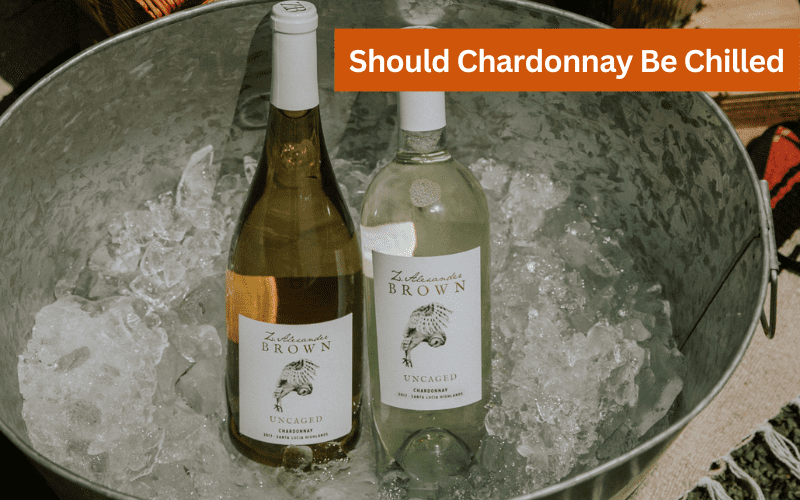As you delve into the fascinating world of wine, a question arises: should Chardonnay be chilled? This perplexing debate has puzzled wine enthusiasts for ages, and I, too, found myself pondering over this conundrum. With each sip of Chardonnay I savored, I embarked on a personal journey to unravel the truth. Drawing upon my own experiences and adventures in wine tasting, I discovered that the answer to should Chardonnay be chilled is far from black and white. So, come along with me as we dispel misconceptions, reveal secrets, and locate the optimal serving temperature for tasting Chardonnay’s actual character.
Do you chill Chardonnay?
Yes, it is common practice to chill Chardonnay before serving. Chilling enhances its refreshing and crisp characteristics, making it a delightful choice for wine enthusiasts.
Does Chardonnay need to be chilled?
Should Chardonnay be chilled? Yes, Chardonnay should be chilled. Cooling it to around 45-55°F (7-13°C) enhances its refreshing acidity, preserves delicate flavors, and maintains its balance. Avoid excessively low temperatures that may mask its nuances. Enjoy a perfectly chilled glass of Chardonnay!

Is Chardonnay best chilled?
Yes, Chardonnay is often best enjoyed when chilled. Chilling the wine can help bring out its refreshing and vibrant characteristics, enhancing the overall tasting experience.
How to chill Chardonnay
To chill Chardonnay properly, follow these steps:
- Select a cooling method: Choose between using a refrigerator, an ice bucket, or a wine cooler.
- Timing is key: Plan ahead and allow enough time for chilling. Generally, 2-4 hours in a refrigerator or 20-30 minutes in an ice bucket should suffice.
- Optimal temperature: Aim for a temperature range of 45-55°F (7-13°C) to preserve the wine’s flavors and acidity.
- Avoid over-chilling: Be cautious not to excessively chill Chardonnay, as extremely low temperatures can mask its delicate nuances.
- Quick chill methods: If short on time, consider using a rapid cooling method such as placing the bottle in a salted ice bath or using a wine chilling sleeve.
- Monitor the temperature: Use a wine thermometer to periodically check the wine’s temperature, ensuring it remains in the desired range.
By following these steps, you can enjoy a perfectly chilled bottle of Chardonnay, unlocking its refreshing qualities and maximizing your wine experience.
Is it ok to over chill Chardonnay?
Over-chilling Chardonnay is not recommended. Extremely low temperatures can mask the wine’s delicate flavors and aromas, diminishing the overall tasting experience.
It is best to avoid over-chilling and aim for the optimal temperature range of 45-55°F (7-13°C) to fully appreciate the nuances and characteristics of Chardonnay.
How long should Chardonnay be chilled?
The duration for chilling Chardonnay depends on the method used. Generally, it is recommended to chill Chardonnay for approximately 2-4 hours in a refrigerator. If using an ice bucket, chilling for 20-30 minutes should be sufficient
Should you chill chardonnay for many styles?
So, should Chardonnay be chilled for many different styles? When it comes to different styles of Chardonnay, the chilling recommendations can vary. Here’s how to chill Chardonnay for different styles:
Crisp and Unoaked Chardonnay
- Chill Crisp and Unoaked Chardonnay in the refrigerator for about 2-3 hours.
- Aim for a temperature range of 45-50°F (7-10°C).
- Lighter, fruit-forward styles benefit from a slightly cooler temperature.
Rich and Oaked Chardonnay
- Chill Rich and Oaked Chardonnay in the refrigerator for approximately 1-2 hours.
- Target a temperature range of 50-55°F (10-13°C).
- Slightly warmer temperatures help reveal the complex flavors and aromas.
Sparkling Chardonnay
- Chill sparkling Chardonnay in the refrigerator for around 3-4 hours.
- Aim for a temperature of 40-45°F (4-7°C) to retain the effervescence and freshness.
Remember, these are general guidelines, and personal preferences may vary. Adjust the chilling time and temperature within the recommended ranges to suit your taste and enhance your enjoyment of each Chardonnay style.

Is Chardonnay supposed to be chilled or cold?
Chardonnay is typically meant to be chilled, rather than served extremely cold. The recommended temperature range for chilling Chardonnay is around 45-55°F (7-13°C). This temperature range allows the wine to showcase its flavors, aromas, and balance while still providing a refreshing and crisp experience.
It is important to avoid serving Chardonnay too cold, as excessively low temperatures can mask its delicate nuances and affect the overall enjoyment of the wine.
Dos and don’ts when chilling Chardonnay
Now you know should Chardonnay be chilled or not, it’s time to explore dos and don’ts when chilling. Finding the perfect temperature is key to enhancing its flavors and enjoying a delightful glass. To ensure you make the most of your Chardonnay experience, here are some essential dos and don’ts to keep in mind.
Dos when chilling Chardonnay
- Do chill Chardonnay in the refrigerator for 2-4 hours before serving.
- Do aim for a temperature range of 45-55°F (7-13°C) to enhance its flavors and acidity.
- Do use a wine thermometer to monitor and ensure the wine remains within the desired temperature range.
- Do consider using a wine cooler or an ice bucket for quick chilling if short on time.
- Do experiment with different chilling times and temperatures to find your preferred balance.
Don’ts when chilling Chardonnay
- Don’t over-chill Chardonnay, as extremely low temperatures can mask its delicate nuances.
- Don’t use a freezer for rapid chilling, as it can lead to excessive cooling and affect the wine’s characteristics.
- Don’t leave Chardonnay at room temperature for an extended period before serving, as it may lose its desired chilled qualities.
- Don’t forget to consider the wine’s style and personal preference when determining the optimal chilling time and temperature.
- Don’t rush the chilling process by using warm water or other methods that can compromise the wine’s quality.
How to store chilled Chardonnay
When storing chilled Chardonnay, follow these guidelines:
- Temperature: Maintain a consistent temperature in the storage area, ideally between 45-55°F (7-13°C). This helps preserve the wine’s quality and prevents fluctuations that can affect its taste.
- Darkness: Store Chardonnay bottles away from direct sunlight or strong artificial light. UV rays can degrade the wine and alter its flavors over time. Opt for a dark or dimly lit area.
- Horizontal Position: If storing for a longer period, consider laying the Chardonnay bottles horizontally. This keeps the cork moist, preventing it from drying out and allowing air to seep into the bottle.
- Humidity: Maintain moderate humidity levels, preferably between 50-80%. This helps prevent the cork from drying and potential air leakage. Avoid excessively high humidity, as it can promote mold growth.
- Avoid Vibrations: Keep the Chardonnay bottles away from sources of vibration, such as appliances or heavy traffic areas. Vibrations can disturb the sediment in the wine and affect its overall quality.
- Limited Exposure: Minimize unnecessary movement and handling of chilled Chardonnay bottles to avoid disturbing the wine and its sediments.
Should Chardonnay be refrigerated?
Yes, refrigeration is commonly recommended for Chardonnay. This temperature range allows the wine to showcase its refreshing acidity, delicate flavors, and balanced characteristics.
However, it’s important to note that while refrigeration is suitable for short-term storage and chilling, long-term storage of Chardonnay should be done in a wine cellar or a cool, dark place to maintain its quality.
How long does Chardonnay last in the fridge?
Chardonnay can typically last in the refrigerator for about 3-5 days after opening. However, it’s crucial to note that the exact duration can vary depending on factors such as the specific bottle, storage conditions, and personal preferences.
To maintain its quality, reseal the bottle tightly with a cork or wine stopper and store it upright in the refrigerator. It’s worth noting that the flavor profile may change slightly over time, so it’s best to consume the Chardonnay within a few days for optimal enjoyment.
How to serve Chardonnay
To serve Chardonnay properly, follow these steps:
- Temperature: Ensure the Chardonnay is chilled to the recommended temperature range of 45-55°F (7-13°C). This can be achieved by following the appropriate chilling methods.
- Glassware: Use a medium-sized white wine glass with a wide bowl and tapered rim. This shape helps capture and concentrate the wine’s aromas.
- Pouring: Hold the wine glass by the stem to avoid warming the wine with your hand. Pour a moderate amount, filling the glass to one-third or halfway to allow room for swirling and aeration.
- Observing: Take a moment to observe the wine’s color and clarity. Chardonnay can vary from pale straw to golden hues, and clarity indicates quality.
- Swirling: Gently swirl the glass to release the wine’s aromas. This action introduces oxygen and enhances the aromatic profile.
- Aromas: Bring the glass to your nose and inhale the aromas. Notice the fruity, floral, or oaky scents that characterize Chardonnay.
- Tasting: Take a sip and allow the wine to coat your palate. Notice the flavors and texture. Chardonnay can offer a range of taste profiles, from crisp and citrusy to creamy and buttery.
- Pairing: Consider Chardonnay’s versatility for food pairing. It pairs well with poultry, seafood, creamy sauces, and dishes with buttery or nutty elements. Experiment with different combinations to find your favorites.
Remember, serving Chardonnay is a personal experience. Feel free to adjust these steps based on your preferences and the occasion. Enjoy the delightful journey of serving and savoring Chardonnay!

Factors affecting wine temperature
Several factors can influence the temperature at which wine should be served. Here are some key factors affecting wine temperature:
- Wine Varietal: Different wine varietals have their own optimal temperature ranges. Light-bodied whites like Sauvignon Blanc are typically served colder, while full-bodied reds like Cabernet Sauvignon are served slightly warmer.
- Wine Style: The style of wine, such as crisp and refreshing or rich and oaky, can impact the ideal serving temperature. Lighter wines are often enjoyed at cooler temperatures, while heavier wines may benefit from slightly higher temperatures.
- Climate and Season: The climate and season in which the wine is being served can influence temperature preferences. In warmer climates, wines may be served slightly cooler to counteract the heat, while in cooler climates, slightly warmer temperatures may be preferred.
- Personal Preference: Individual taste plays a significant role in wine temperature. Some people prefer their wines cooler to enhance acidity and freshness, while others enjoy slightly warmer temperatures to bring out the wine’s complexity and flavors.
- Food Pairing: The type of food being paired with the wine can impact the serving temperature. Lighter dishes often call for cooler wines, while richer and heavier foods may be complemented by slightly warmer wines.
- Age of Wine: Older wines, particularly reds, are often served at slightly warmer temperatures to enhance their aromas and flavors. Younger wines, especially whites and rosés, are typically enjoyed chilled to maintain their freshness.
Considering these factors and striking a balance between personal preference and recommended temperature ranges will ensure that you serve and enjoy your wine at its best.
What is the best Chardonnay serving temperature?
The best serving temperature for Chardonnay is typically between 45-55°F (7-13°C). This temperature range allows the wine to showcase its vibrant acidity, express its aromatic qualities, and maintain a balance between its flavors and structure.
Chilling Chardonnay within this range helps preserve its delicate nuances, crispness, and refreshing characteristics.

Which glass should Chardonnay be served in?
Chardonnay is best served in a medium-sized white wine glass. The ideal glass has a wide bowl and a tapered rim. This shape allows for better aeration, capturing and concentrating the wine’s aromas.
The wide bowl also provides ample space for swirling the wine, which further enhances the aromatic profile. By choosing the right glassware, you can fully appreciate the nuances and complexities of Chardonnay as you savor each sip.
How to deal with warm Chardonnay without ruining it after chilling?
If you have a warm bottle of Chardonnay that needs to be chilled without compromising its quality, here’s what you can do:
- Ice Bucket Method: Fill a bucket with ice and water. Submerge the bottle in the ice bucket for about 15-20 minutes, rotating it occasionally. This method helps cool the Chardonnay gradually without shocking the wine.
- Rapid Cooling Sleeve: Use a wine chilling sleeve or wrap the bottle with a damp cloth. Place it in the freezer for about 15-20 minutes. The sleeve or damp cloth helps speed up the cooling process. Be cautious not to leave it in the freezer for too long to prevent over-chilling.
- Salted Ice Bath: Fill a bucket with ice and water, adding a handful of salt to the mixture. Submerge the bottle in the salted ice bath for approximately 10-15 minutes. The addition of salt lowers the freezing point of water, enabling faster cooling.
- Decant and Chill: If time permits, pour the Chardonnay into a decanter or a pitcher with ample surface area. Place it in the refrigerator for 30-45 minutes. Decanting allows for more rapid cooling as the wine is exposed to a larger surface area.
While these methods help cool down the Chardonnay, it’s necessary to monitor the temperature closely to prevent over-chilling. Aim to reach the recommended serving temperature range of 45-55°F (7-13°C) for optimal enjoyment of Chardonnay’s flavors and characteristics.

Chardonnay and Food Pairing
Chardonnay is a versatile wine that pairs well with a variety of foods. Here are some food pairing suggestions to enhance your Chardonnay experience:
- Poultry: Roasted chicken, turkey, or duck are classic pairings with Chardonnay. The wine’s acidity complements the richness of the meat.
- Seafood: Chardonnay pairs wonderfully with various seafood dishes. Try it with grilled or poached fish, shrimp, lobster, or scallops. The wine’s crispness complements the delicate flavors of the seafood.
- Creamy Sauces: Chardonnay’s fuller body and buttery notes make it a great match for dishes with creamy sauces like Alfredo or béchamel. The wine’s acidity helps cut through the richness.
- Soft Cheeses: Pair Chardonnay with soft and creamy cheeses such as Brie, Camembert, or goat cheese. The wine’s acidity and fruitiness complement the richness of the cheese.
- Pasta: Chardonnay pairs well with pasta dishes, particularly those with creamy or butter-based sauces. Think fettuccine Alfredo, carbonara, or pasta with white wine sauce.
- Roasted Vegetables: Chardonnay’s medium to full body and subtle oak flavors complement roasted vegetables like butternut squash, sweet potatoes, or cauliflower.
- Nuts and Seeds: Chardonnay’s nutty and toasty flavors make it an excellent match for dishes featuring nuts or seeds, such as almond-crusted fish or sesame chicken.
Should Chardonnay be chilled vs. Other white wines
| Chardonnay | Sauvignon Blanc | Riesling | |
| Chilling | Yes | Yes | Yes |
| Temperature | 45-55°F | 40-50°F | 40-50°F |
| Flavor Profile | Varies (Crisp to Rich) | Crisp, Herbaceous | Crisp, Sweet to Dry |
| Acidity | Medium to High | High | High |
| Aromas | Fruity, Floral, Oaky | Citrus, Herbaceous | Floral, Fruity |
| Food Pairing | Poultry, Seafood, Creamy Sauces | Seafood, Salads | Spicy Cuisine, Asian Dishes |
FAQs
Is Chardonnay better warm or cold?
Chardonnay is generally better when chilled rather than served warm. Cooling it to a temperature range of 45-55°F (7-13°C) enhances its refreshing qualities and helps maintain its balance.
Do people put ice in Chardonnay?
It is not common to put ice directly in Chardonnay. Adding ice cubes can dilute the wine and alter its flavors. Instead, it is advisable to chill the wine to the desired temperature before serving.
Can you drink Chardonnay that was left out overnight?
It is not recommended to drink Chardonnay that has been left out overnight. Once exposed to air for an extended period, the wine can oxidize and lose its desirable flavors. It is best to refrigerate or discard any leftover wine.
What makes Chardonnay go bad?
Factors such as exposure to oxygen, excessive heat, or improper storage conditions can make Chardonnay go bad. When exposed to these elements, the wine can become oxidized, lose its flavors, and develop off-putting aromas.
Is 15 year old Chardonnay still good?
Whether a 15-year-old Chardonnay is still good depends on various factors, including the specific wine, storage conditions, and the producer’s recommendations. Generally, well-made Chardonnays with good aging potential can develop complex flavors over time. However, it is advisable to consult a wine expert or trusted source to assess the quality of a specific bottle.
Can Chardonnay go bad if unopened?
Chardonnay can go bad if unopened but exposed to adverse conditions such as extreme temperatures or prolonged exposure to sunlight. Proper storage in a cool, dark place can help preserve the wine’s quality for an extended period.
How can you tell if Chardonnay is good?
To determine if Chardonnay is good, assess its color, clarity, and aroma. A well-preserved Chardonnay typically has vibrant color, clarity without any haze or sediment, and aromas that are fresh, fruity, and characteristic of the varietal.
Can I drink Chardonnay straight from the fridge?
While you can drink Chardonnay straight from the fridge, allow it to warm up slightly in the glass to fully appreciate its aromas and flavors. Chardonnay’s characteristics may be more pronounced as the wine warms slightly.
Should I decant Chardonnay before serving?
Decanting Chardonnay is generally not necessary unless it is a highly complex and aged Chardonnay. Most Chardonnays can be served directly from the bottle without decanting.
Can I chill opened Chardonnay and consume it later?
Yes, you can refrigerate opened Chardonnay and consume it within 3-5 days. Reseal the bottle tightly to help preserve its quality.
Conclusion
As shown above, the question of should Chardonnay be chilled has led me on a fascinating journey of exploration and discovery. Through delving into the origins, characteristics, and flavor profile of Chardonnay, as well as understanding the impact of temperature on wine, I have come to appreciate the nuanced relationship between chilling and the enjoyment of this beloved varietal. The key lies in striking a balance between temperature and personal preference, allowing each sip to be a tailored delight.
So, whether it’s a crisp unoaked Chardonnay or a rich and buttery oaked expression, I believe that the decision to chill Chardonnay ultimately rests in the hands of the individual, guided by their own taste and the occasion. So, go ahead, explore the diverse world of Chardonnay and unlock its secrets, chilled to perfection.
I’m Chen Mina, from Vol de Nuit, who has a special passion for bartending, especially mixing wine, beer, and cooktail. Here you will find content about alcoholic beverages, I will bring you knowledge that few people know about this drink.





